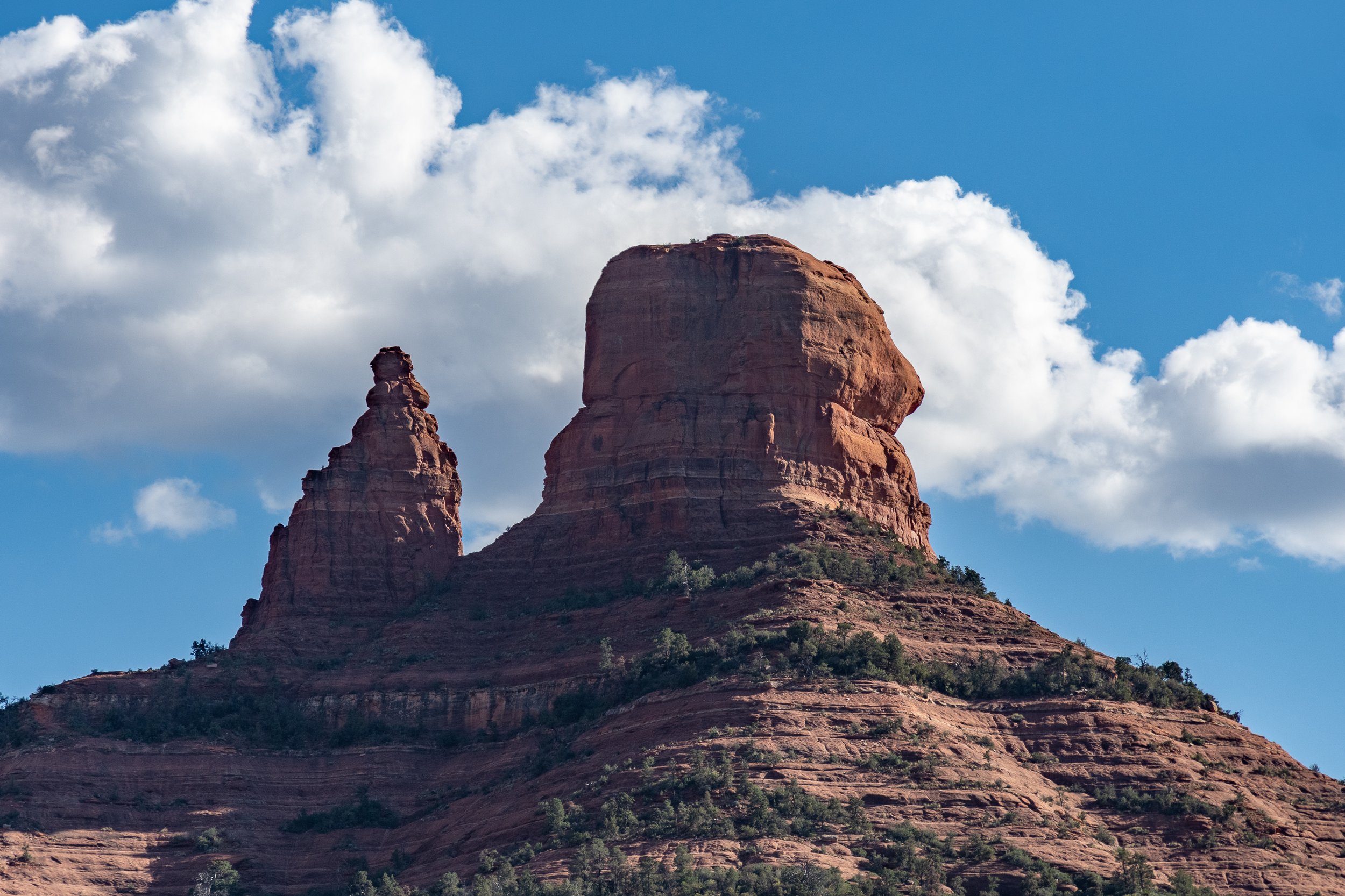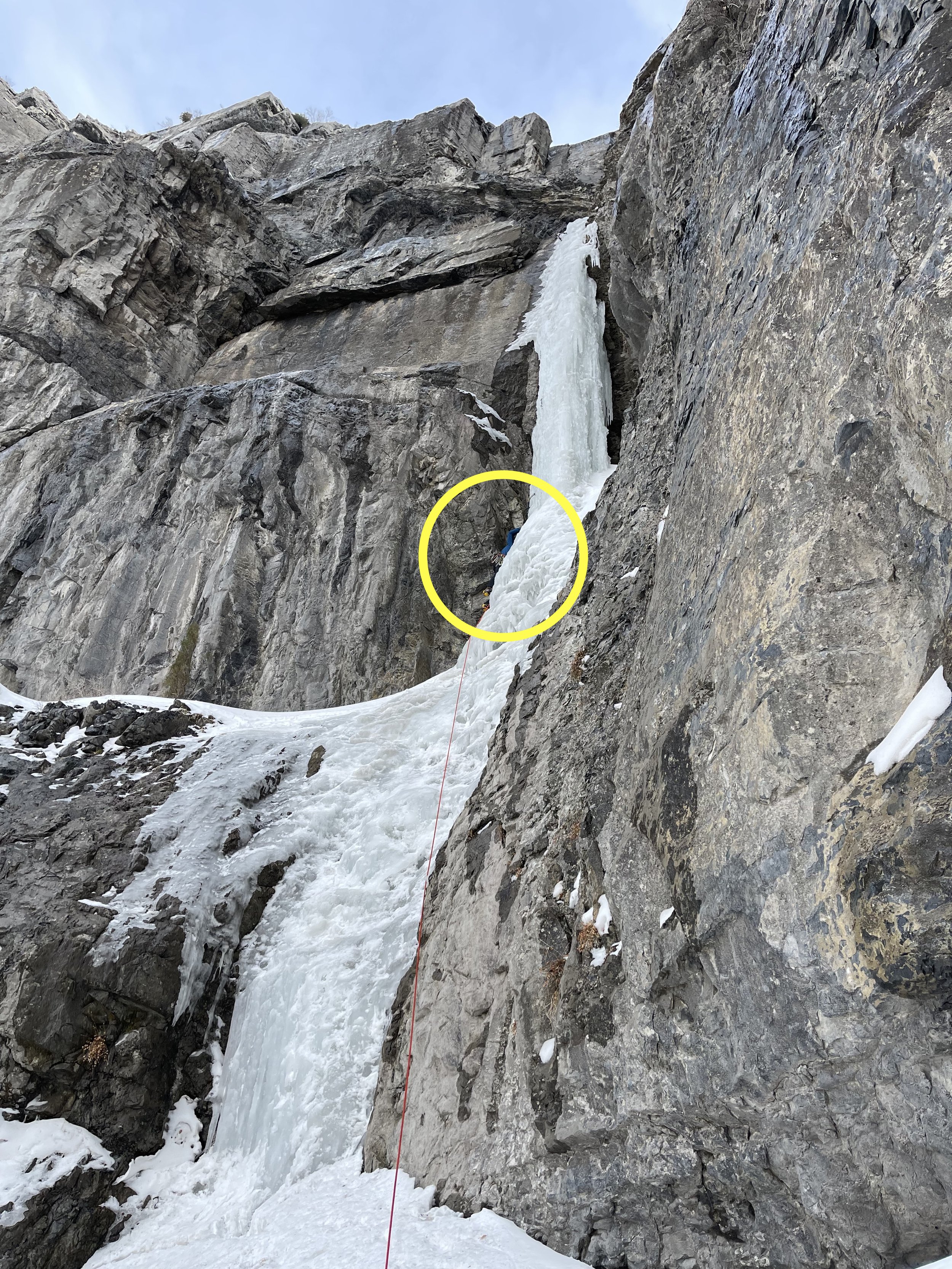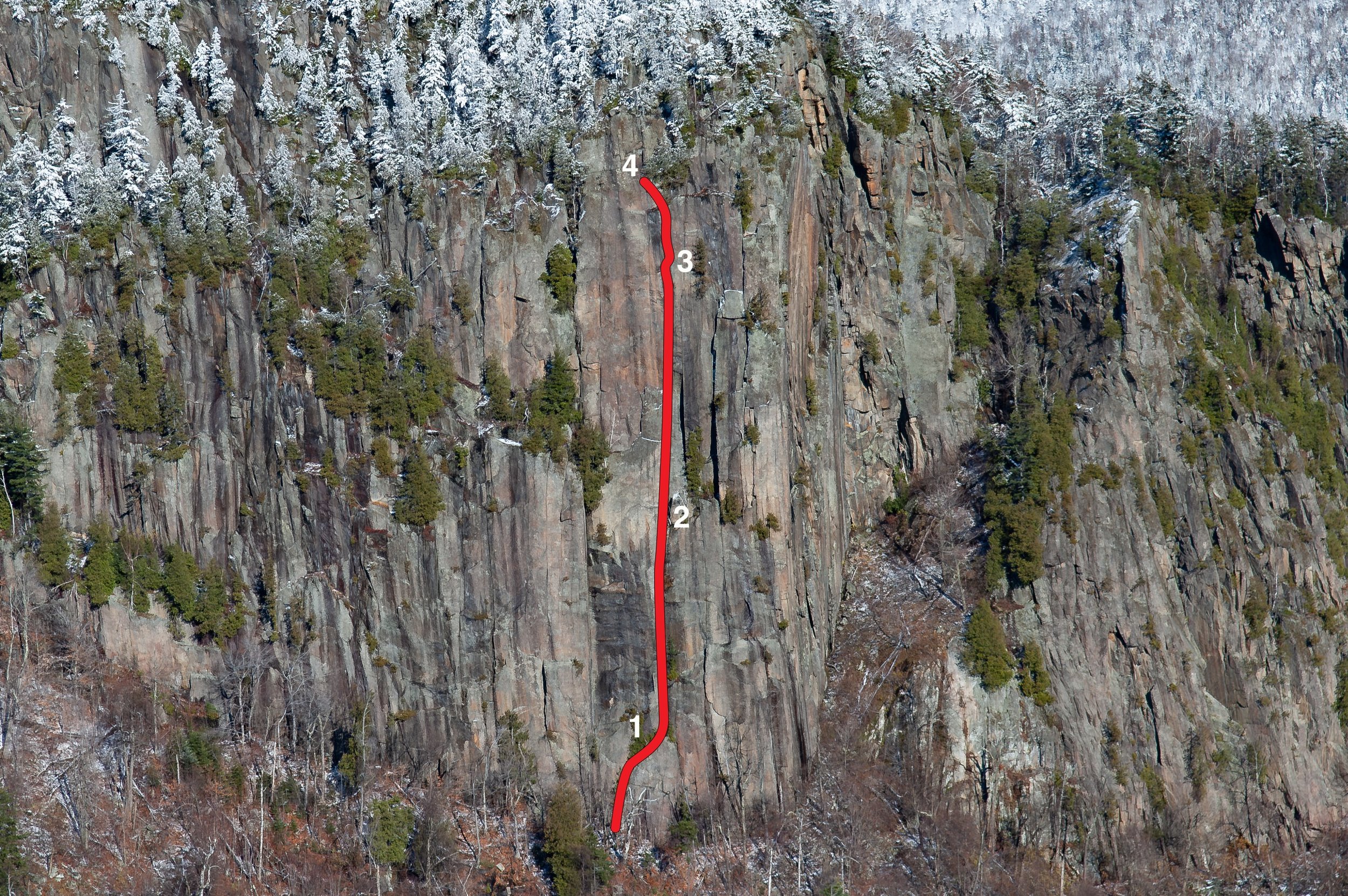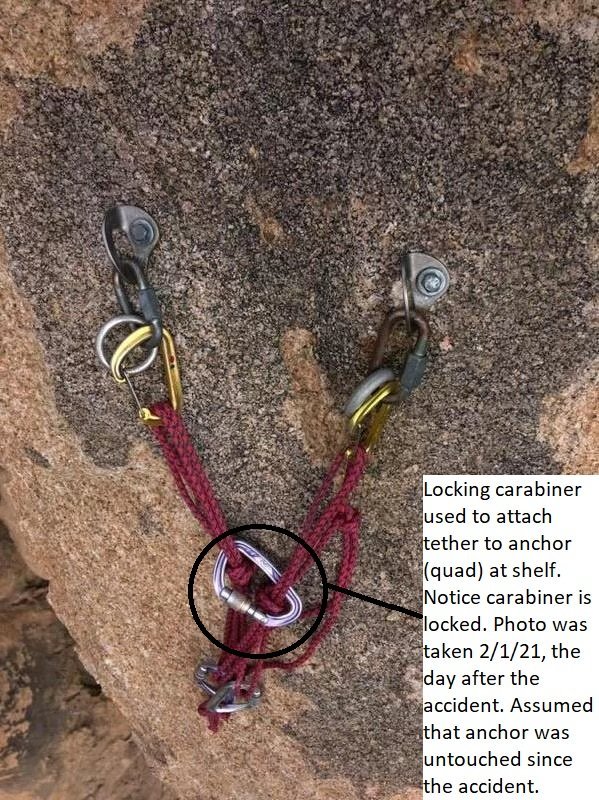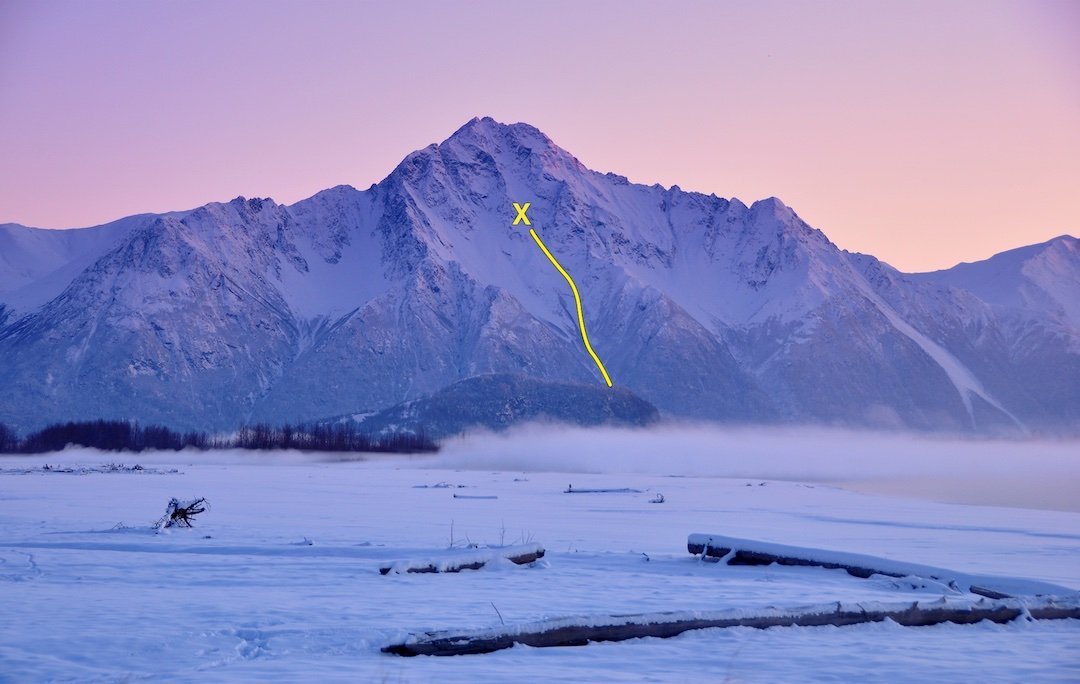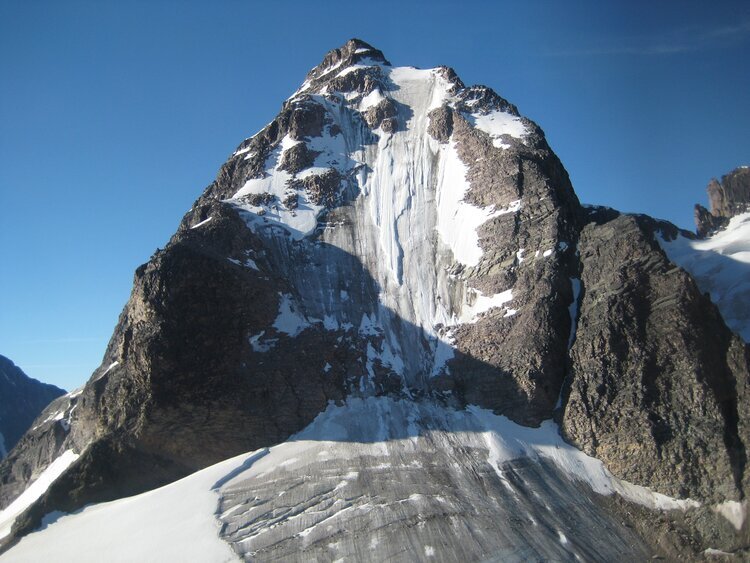THE PRESCRIPTION
YOUR MONTHLY DOSE OF ACCIDENTS IN NORTH AMERICAN CLIMBING
Now you won’t have to wait all year for fresh stories and lessons about climbing accidents and near misses. The Prescription brings you monthly unpublished accident reports, tech tips, links to new online educational resources, and much more—all aimed at helping you become a safer climber.
THE PRESCRIPTION—AUGUST 2025
Besides being prime time in the high country, summer is a high-traffic season for alpine rock and long moderate climbs. This time of year, climbers of all levels venture unroped onto “easy” terrain. Every year, we also see a handful of free solo accidents. These are almost always fatal and usually take place on well-trafficked moderate routes.
On December 16, 2024 the Boulder County Sheriff’s Office received a report that 42-year-old Keith Hayes did not return home that evening. Around 9 p.m., friends of Keith found his body near the top of Second Flatiron after he presumably fell while unroped from Freezeway (5.7). Friends of Hayes report that there was no sign of snow or ice on the route and that there was no sign of broken rock contributing to the fall.
This July, we look back at an accident in 2019. A climber took a serious lead fall while clipping the third bolt on a popular sport route in North Carolina called Chicken Bone (5.8). This climber made a fairly common error when his rope crossed behind his leg while climbing. This oversight resulted in serious injury from what should have been a routine fall.
During the afternoon of May 6, Ranger J. Anderson received a call reporting a fallen climber. When Anderson found the patient, Matthew Starkey, he was walking out, holding a shirt on the right side of his head and covered in blood. However, he was conscious and alert. After ensuring the patient’s condition did not worsen, Anderson accompanied him on the hike. Medical assessment revealed a two-to three-inch laceration on the right side of his skull and light rope burns on his leg.
This month, we recall a tragic accident from 2023 ANAC. While recalling this accident is disturbing, it’s important to understand that there were 14 published rappel accidents that year, eight of which resulted in fatalities. The trend shows no sign of abating. In the upcoming 2025 ANAC, our data tables record a total of 15 reported rappel incidents that involved 23 climbers and ended with five fatalities. It’s not all bad news. In the 2025 ANAC, we also feature an article with tips for improved rappel safety from John Godino of Alpinesavvy.com.
On Wednesday, September 28, 2022, Chelsea Walsh (33), a documentary filmmaker, and Gavin Escobar (31), an ex–Dallas Cowboys football player, died in a fall at Tahquitz Rock (Lily Rock). The Riverside Mountain Rescue Unit (RMRU) responded to the accident and later provided an in-depth analysis. They concluded that a degraded rappel sling caused the fatal fall of several hundred feet. This was one of two fatal accidents in 2022 due to a broken rappel-anchor sling.
THE PRESCRIPTION—MAY 2025
On July 9, 2022 Anna Laila Leikvold (22) was preparing to climb at the Wizard’s Gate crag, south of Estes Park, when she was struck by a rock falling from a route called The Arrival (4 pitches, 5.11). Leikvold, who was wearing a helmet, was at the base of the cliff in a party of three when a football-sized rock dislodged by another climber struck her as she was fleeing from the base of the wall. Read about the accident and how to stay safe at the crag.
THE PRESCRIPTION—MARCH 2025
On January 8, 2023, Climber 1 (female, 25) was following four friends on the Regular Route (3 pitches, 5.7) on Queen Victoria Spire in Sedona. When Climber 1 attempted an “alpine knee” while pulling a ledge, she slipped. The slip resulted in her knee getting stuck in the four-inch-wide-crack. Stuck for hours, Climber 1 nearly got hypothermia. Read about the SAR rescue, how to prevent this, and what to do if it happens.
THE PRESCRIPTION—FEBRUARY 2025
On October 8, 2024 Whitney Clark was ascending a fixed rope at the start of Valkyrie (17 pitches, 5.11+). Although an expert climber, she made two crucial errors in her rope ascension/top-rope solo system when her single ascension device was jammed by a sling. She fell 30 feet to the ground. She fortunately escaped with relatively minor injuries.
THE PRESCRIPTION—JANUARY 2025
It’s bouldering season in Hueco Tanks, Texas. While most consider bouldering relatively safe, it is perhaps the most accident and injury plagued facet of climbing. This month we bring you an accident that took place on a famous John Sherman highball called See Spot Run.
On January 22, 2024, Pete Korpics was attempting to climb a long-standing project called See Spot Run (V6). He was well aware of the risks involved and that it would require ample padding. During an attempt, he fell from roughly fifteen feet up, with quite a bit of force. Despite ample padding, the fall resulted in an ankle injury.
Utah County Sheriff’s Search and Rescue was dispatched at 11:09 a.m. on December 26 to aid an ice climber who had fallen from the first pitch of Finger of Fate (3 pitches, WI4+) in Provo Canyon. The climber, Tim Thompson (29), was nearing the end of the first pitch when ice sheared from under his left foot. He wrote to ANAC that he was “pushed forward into my ice tools and my relaxed grip caused me to fall.” Thompson’s uppermost screw pulled out of the ice, causing him to fall a total of 50 feet.
This November, we have an accident involving an alpine quickdraw. Disturbing as it may sound, we get periodical reports of quickdraws becoming unclipped from bolt hangers. In 2023 alone, three accidents were reported in which a quickdraw unclipped or snagged on a bolt hanger. The latter instances resulted in broken carabiners.
“My climbing partner and I went sport climbing at Pilot Mountain State Park in March 2023… [While cruxing] I got partially over the bulge and needed to make one more move but couldn't find a good handhold. I ended up falling off. Instead of stopping, I hit the ground after falling 20 feet. Both feet landed on a flat rock step on the main hiking trail. My belayer took up enough slack so that the rope started to catch right as my feet hit. After lying on the ground, overcoming the initial shock and pain, I realized that the alpine quickdraw that I had clipped into the third bolt was still clipped to the rope,” Alec Gilmore writes in his ANAC report.
Cams might not be as bomber as you think. .We are stoked to kick off our Prescription video series by unpacking some magical thinking around cams. This video series will give you greater detail and visual insight into the accidents analyzed in our monthly Prescription newsletters. Featuring Accidents in North American Climbing Editor Pete Takeda, and IFMGA/AMGA Mountain Guide Jason Antin, these bite-sized lessons will get you thinking about how this accident analysis applies to you and your climbing.
For Rocktober we have two accidents that represent a larger trend we noticed in 2023. This trend involves: 1) Placing an inadequate number of protection pieces and 2) Poorly placed camming protection.
On August 5, a party of two started up Simple J Malarkey (3 pitches, 5.7). On the final pitch, Danny Gerhart called down to his belayer, informing them that he was going to take a deliberate fall.
He then let go and fell around 12 feet before loading the rope. The belayer reported having enough time to take in two to four feet of slack before hearing a very loud “gunshot” as the rope exploded. The belayer never felt the falling climber load the belay, and tragically, Gerhart fell approximately 130 feet to the ground, passing away at the scene.
The following report describes an accident in the Canadian Rockies that will be published in the upcoming 2024 Accidents in North American Climbing. While reviewing last year’s accidents, a particularly improbable incident stood out. Almost exactly a year ago, a climber fell, unroped, from the fourth-pitch belay anchor of a 15-pitch climb. After tumbling 35 meters, he came to rest on a ledge three pitches above the ground, having suffered only minor injuries. One might attribute this incident to a form of benign intervention, a guidance bordering on the divine. Or it might have been simple good luck. Read on.
Summer has officially arrived and climbers are turning their attentions to northerly latitudes, higher elevations, and lofty peaks. This month we feature two accidents that took place last summer on Teewinot (12,330 feet) in Grand Teton National Park, Wyoming. While these accidents differ in immediate cause and final outcome, they share a common origin: the use of hiking-specific applications for selection, preparation, and route-finding, versus the use of climbing-specific resources.
Around 12:40 p.m. on September 28, Larsen Tormey (28) was pinned under a large boulder while hiking out after an attempt on the Evolution Traverse (VI, 5.9). His climbing partner, Jacob Ireland (35), was able to free him after several hours, prior to the arrival of SAR. The accident took place five miles from the trailhead. Lars was hiking ahead of me. I was at the top of Lamarck Col when I heard someone yelling. I figured this was Lars, but I couldn’t spot him. As I headed toward the sound the cries grew louder, and I knew that an accident had occurred. When I was directly above his voice, I could hear clearly, “I’m stuck! There’s a rock on me! Please help!”
THE PRESCRIPTION—APRIL 2024
The Denali climbing season is imminent. The peak’s high latitude, extreme altitude, and arctic climate present hazards that challenge even the most experienced climbers. Our April “Prescription” is a Denali National Park accident summary, accompanied by an altitude illness report from the peak’s most popular route. While mishaps involving crevasses, avalanches, and falls plague climbers every year, altitude illness is the most preventable cause of incidents on Denali.
On February 24, 2021, Dawson Riley (21) and his friend (19) were enjoying a day out at Mt. Woodson. Riley, an experienced climber, had taken this friend climbing a few times before. Riley first led the 35-foot route Robbins Crack (5.10a) and attached a quad anchor sling to the bolts atop the large boulder. His friend then followed, with Riley belaying from above on a Grigri. Riley then adjusted the position of the anchor so that they could lower each other and climb Lie Detector (5.12a/b), another crack route (the analog to Robbins Crack) that shares the same bolt anchor.
The ice and mixed season is in full swing. While offering a dazzling range of sights, sounds, and textures, winter climbing arguably presents the highest risk to life and limb of any crag-oriented climbing genre. Ice is an ever-changing medium. The clothing and tools required deprive climbers of the accustomed “feel” for the climbing medium—so critical to fair-weather rock climbing. This month we have two accidents from 2023. Both involved collapsing ice formations. One had an injury-free ending. The other ended in tragedy.
On November 9, 2023, Gibson McGee (19) was bouldering on White Rastafarian, a V2 (often graded V3) highball that has been the scene of many accidents. He fell from near the top and struck the ground, shattering his L1 vertebra, the highest bone in the lower back. Though Mountain Project describes White Rastafarian as “one of JTree’s finest (problems),” the climb is 25 feet tall—more a short route instead of a boulder problem. After the midpoint crux, the climber is faced with a tricky mantel topout.
On October 14, Yutung “Faye” Zhang (18) fell 90 feet from the anchors of Misty (5.10b/c) while cleaning this route at Sand Rock in northeastern Alabama. It was her second time climbing outdoors. At around 12 p.m., Zhang, a new climber and part of a larger group, took a final top-rope lap on the route. She cleaned the quickdraws and reached the two-bolt anchor. The anchor was equipped with two mussy hooks plus a single locking carabiner that had been placed by one of the other climbers to prevent the rope from unclipping from the mussys.
On February 24, 2023, Steve Sagin (58) and Jerry Cagle (70) were climbing Wily Javelina (6 pitches, 5.9, PG-13) on Table Dome in the remote Mendoza Canyon, southwest of Tucson. On pitch five, Sagin broke a hold and took a long leader fall.
Cagle recounted the following in a report to ANAC: “We began planning for this climb with a check of the predicted weather for the day: pleasantly warm around midday with an occasional light breeze. Our spouses were informed of our plans.
On March 14, 2023, my friend (the belayer) and I (Liu Yuezhang, 26) headed to Time Wave Zero (2,000’, III 5.12a or 5.11 A0) in El Potrero Chico (EPC) to check out the approach and prepare for a full attempt a few days later. Our plan was to try the moves of the first two pitches before returning to the ground. While following the second pitch (95’, 5.11b, nine bolts), I experienced a belay failure from above, hitting my right lower back, head, and both elbows as I fell. I was rescued by the EPC rescue team and local climbers. Miraculously, I was not seriously injured.
At 6:30 p.m. on October 16, 2022, the New York State Department of Environmental Conservation (DEC) rangers received a call from two climbers who were stranded on Moss Cliff in Wilmington Notch within Adirondack State Park. The two climbers had topped out on a four-pitch trad climb called Hard Times (5.9+) and had completed their first double-rope rappel from the bolted rappel station at the top of the final pitch. When the climbers went to pull their ropes after the first rappel, the rope would not budge. After repeated attempts to pull the ropes down, the climbers considered themselves to be stranded and used a cell phone to contact rangers.
THE PRESCRIPTION—AUGUST 2023
On June 28, at 10:59 a.m., Yosemite Dispatch received a report of a 42-year-old male who had taken an approximately 50-foot fall on The Prow (V 5.8 C2) on Washington Column. The climber’s plan had been a multi-day, aid-solo ascent. On the second pitch, the climber fell, ripped rock protection, and struck a ledge. He recalled, “I felt the sensation of falling—it was so sudden and so fast. Then I remember hitting a ledge hard, bouncing, sliding. I remember hitting two more small ledges on the way down.”
On August 12, 2022, a party of two climbers left the Hind Hut to ascend the North Ridge of Mt. Assiniboine (AD 5.5). By late morning, they had reached one of the steeper upper steps at about 3,500 meters (11,482 feet). The pair had soloed everything up to this point and arrived several minutes apart. The first climber to arrive (Climber 1) assessed the next step and determined they would likely use a rope due to the steep angle and sloping nature of some of the holds. When Climber 2 arrived, the pair took a break and considered their options. Meanwhile, a separate party downclimbed the step. This party was unroped.
On July 6, 2022, Alex Satonik and Peter Haley climbed the classic East Ridge of Wolf's Head (10 pitches, 5.6). The climb was uneventful. Satonik wrote to the ANAC that, “We arrived at the summit around 11 a.m. We had a brief rest and then started the standard descent route." The way down started smoothly; the first two rappels were easy to find, and the cordage looked good on both. Upon arriving at the third rappel, it was difficult to see the entire cordage on the anchor. This was the first sign of danger. Immediately after weighting the anchor, Alex fell 50 feet.
THE PRESCRIPTION—APRIL 2023
On September 3, 2022, Kyra Harames (female, 24) was climbing with a group of friends at The Kitchen in Rock Canyon. After setting up a top-rope, she fell to the ground while rappelling from the two-bolt anchor. While this story has a happy ending, we cannot be absolutely certain of the accident’s cause. However, one theory seems to check all the boxes.
On July 10, 2022, Will Toor (60) and his wife, Mariella Colvin (59), fell down the East Couloir (II, AI2 or 65°snow) on the north face of Flattop Mountain. At the top, a cornice collapsed, causing Toor to fall. The dislodged debris struck Colvin and they both tumbled 900 feet. Colvin left her immobilized husband to try to get help, bushwhacking nearly two miles despite having suffered broken ribs, a broken sternum, a broken wrist, and three fractured vertebrae. While she was gone, two climbers on an adjacent peak came over to assist Toor and summoned a National Park Service rescue. Toor was helicoptered out with a broken femur. Colvin was evacuated the next day.
On June 7, 2021, Ryan Dozier (37) was top-rope soloing at Snowshed Wall at Donner Summit, near Lake Tahoe. Because of windy conditions, he decided to not use his normal back-up system in addition to his Micro Traction. Near the top, he fell, plummeting 50 feet before his system caught his fall. He landed 3 feet above the ground. He wasn’t wearing a helmet.
This month we have an indoor gym accident of a type that sadly occurs with some frequency. This accident has a happy ending and a powerful lesson. On December 14, 2022, Adam Herzog (43) miraculously survived a fall in which he suffered severe injuries after failing to clip into an auto belay in a climbing gym. Upon finishing the climb, he simply let go, and fell 45 feet to the ground. “I feel very lucky to be alive and not paralyzed,” said Herzog.
On December 4, Nathaniel Masahi Takatsuno (22) fell to his death while free soloing Leonids, a three-pitch 5.9 on The Wedge at El Cajon Mountain an hour east of San Diego. Climber Michael Sandler witnessed the accident. In his report to Accidents, he wrote, “As we were waiting (at the base), a single man walked by. I asked what his name was and we made some small talk. His name was Nate, and he was a lab tech at University of California San Diego. He was alone but had a rope, so I asked him what route he was planning to do. He told me he wanted to solo Meteor—I asked if he was going to rope solo.
Our friends in the Canadian Rockies take avalanches seriously. The terrain is big, cold, and snowy. The Rockies are also a popular ice climbing venue that holds a vast trove of some of the best ice in the world. However, those who want to climb cascades, gullies, smears, and drips in this region must pay heed to the perils of avalanches. Fortunately, Avalanche Canada, a not-for-profit organization dedicated to public avalanche safety that issues daily avalanche forecasts throughout the winter and provides avalanche awareness and education programs, recently started the Ice Climbing Atlas Project.
In the evening of October 17, two climbers, Kate (28) and Nick (26), started up the Regular Northwest Face of Half Dome (23 pitches, 5.9 C2) after completing The Nose on El Capitan (31 pitches, 5.9 C2) earlier in the same day. Nick and Kate were both experienced climbers attempting a sub-24-hour link-up of the two walls. They failed to summit Half Dome when they were caught in a winter storm, five pitches from the top.
In June 2021, Tiffany Hauck (50) fell leading a classic climb in Eldorado Canyon, Wind Ridge (4 pitches, 5.7). Hauck fell 30 feet after her pro ripped out. She was able to walk out with minor scrapes and bruises on her shins, and contusions on the hip and buttocks. Two months later an eerily similar accident occurred, proving to be fatal.
In March 2021, Logan Zhang (11) hit a boulder on the ground while cleaning a route in the Motherlode at Red River Gorge. Logan was using the cable car (a.k.a. tram) method to retrieve his draws, staying clipped to the belayer’s side of the rope, as is common when cleaning overhanging routes. Before reaching the ground, he removed the tram draw from the belayer’s rope and fell, hitting a boulder below the climb. Learn more about this type of accident and how to clean steep routes safely. Plus: Stories and lessons from the very first AAC accidents publication, 75 years ago!
THE PRESCRIPTION—JULY 2022
A leader in the Gunks got slightly off-route and stood on a ledge that suddenly collapsed. Even worse, the falling rock severed the rope, leaving the leader stranded 100 feet up the cliff. Plus, what lessons did Molly Mitchell, Hans Florine, and Alex Honnold learn from their own accidents in recent years?
THE PRESCRIPTION—JUNE 2022
Last December, a climber at the base of a popular 5.6 multi-pitch climb in Colorado’s Clear Creek Canyon was killed by a large rock that fell from above. Originally, it was assumed the rockfall likely originated from other climbers. But in the Accidents in North American Climbing report, a different possible culprit is identified: bighorn sheep. Learn about the hazards from sheep and other critters in the June edition of the Prescription.
Read the story of a devastating highball bouldering accident—and a not-recommended-but-turned-out-OK self-rescue—after a ground-up attempt on a first ascent in Canada. Plus, now is the time to review our in-depth article on avalanche prep for summer mountaineering.
The April Prescription features an accident at Squamish, British Columbia, in which a counterweight rappel—in which one climber’s weight anchors one end of the rope so another climber can rappel the other strand of the rope—went terribly wrong. The result was a 200-foot tumbling fall that fortunately did not end with fatal injuries. Plus, how a worn-out harness gear loop led to a potentially dangerous—and potentially very expensive—case of the flying cams!
In March 2019, Jordan Cannon and Hayden Jamieson attempted Logical Progression, a 28-pitch 5.13 in Chihuahua, Mexico, that’s typically approached from above, by rappelling in and climbing back out. Jordan and Hayden stashed gear for two bivouacs on their way down the wall. The first two days went well, as they worked on the crux pitches and bivouacked eight pitches up. But on day three, things took a dramatic turn for the worse. In this edition of the Prescription, Jordan shares the lessons he learned when a serious storm hit them on that climb and how he prepares today for safer big-wall ascents in Yosemite Valley and beyond.
On the afternoon of January 31, 2021, Tim Parker (35) suffered a ground fall from the anchor above Naked Prey (5.12a) in Cochise Stronghold. Parker is a climber with over 15 years of experience. For an anchor tether, he used a double-length sewn nylon runner girth-hitched around both hard points on his harness. Parker had pre-rigged the tether with two overhand knots, dividing the sling into three segments, to allow for various clip-in points and for extending his rappel device. He used a locking carabiner to clip the tether into the shelf of the cordelette anchor. Unbeknownst to him, the carabiner was not properly clipped to his tether. Read the February Prescription to learn exactly what happened next.
The 2021 edition of Accidents introduced a new section covering avalanche incidents in backcountry skiing and snowboarding. In the January Prescription, we shared one of these reports, documenting an accident in which three skiers were caught in a slide on Republic Mountain in southern Montana. The skiers took many precautions yet still ran into trouble when the snowpack thinned and became less stable as them moved along their route. Fortunately, all of the skiers were able to escape.
Read all about it and watch the video analysis by Doug Chabot of Gallatin National Forest Avalanche Center (and a former AAC board member).
The north face of Pioneer Peak, showing the route attempted in the incident below. X marks approximate site of the anchor where the climbers were impacted by avalanches. Photo by Cecil Sanders
The December Prescription features an article from the 2021 edition of Accidents in North American Climbing. Two climbers, Fallon Connolly, 26, and Simon Frez-Albrecht, age 28, were caught in a series of avalanches on Pioneer Peak, northeast of Anchorage, AK. Very fortunately, neither climber was buried, swept all the way down the mountain, or seriously injured, and they were able to self-rescue to the road. We’re calling attention to this story both for the lessons it imparts and for the incredible drama of the events.
The American Alpine Club (AAC) is excited to announce Pete Takeda as the new editor of Accidents in North American Climbing. Pete is a longtime climber and expert in all forms of the sport, from single-pitch routes to big walls to mountain climbs around the world. Pete already has begun the transition into his role, starting work on the 2022 edition of Accidents. We asked him to share a few thoughts about the publication and his new job for the Prescription.
The October Prescription features an accident report from the Red River Gorge as well as great beta on cleaning steep routes safely. Cleaning the last draw while lowering from an overhanging route is always potentially hazardous, as the climber generally will swing out from the wall. To avoid pulling the belayer into a swing as well, the cleaning climber should completely disconnect from the belayer’s side of the rope before letting go from the wall. The belayer can then brace for the swing before the climber unclips the lowest bolt.
Two climbers attempting the West Face of Leaning Tower in June decided to descend after arriving at Ahwahnee Ledge (the top of the fourth pitch), due to excessive heat and sun. While rappelling the very overhanging first pitch with the haulbag, Climber A rappelled over a small roof and got too far away from the wall to reach the ledge at the bottom of the pitch, despite clipping some directionals during his descent. (The West Face route is approached by a ramp that traverses onto the face, so the first anchor is far above the ground.) Since the climber could not reach the ramp, he continued rappelling to a lower ledge and became stranded there. In this month’s Prescription, a Yosemite climbing ranger reports on what happened next. Plus: recommended ways to rappel with a haulbag and avoid this type of incident.
The August Prescription includes two reports from the upcoming edition of Accidents in North American Climbing that share many similarities. Both involved climber-caused rockfall that hit belayers standing on the ground. Both were at sport climbing areas, where many belayers decide not to wear helmets—though, very fortunately, one of these belayers had borrowed the leader’s helmet because of concern about loose rock. In both cases, the belayer was using an assisted-braking belay device (ABD), and, in one case, this very likely saved the leader from a ground fall and significant injuries. Though rare, these incidents should make climbers think about the value of ABDs—and helmets—for belaying single-pitch climbs.
Introducing the first ever Spanish edition of Accidents in North American Climbing. Accidentes was translated by a team of volunteers. Read this month’s prescription to learn more about Omar Gaytan, the director of our translator team. Mexico is part of North America, of course, but it hasn’t always been a big part of Accidents in North American Climbing. One side benefit of this translation project, we hope, will be increased access to information about climbing in Mexico and other Spanish-speaking areas of North America, including Puerto Rico. In this way, we hope the AAC can help climbers learn more about both the opportunities and hazards in these beautiful areas. Lastly, the month’s edition includes a report from El Gigante in Basaseachic Falls National Park.
A sneak peak at the 2021 ANAC: Learn about a fall in Banff National Park that involved a pulled cam and an ensuing helicopter rescue. Read about the accident and some best practices for placing protection in dirty, slick, or wet rock. Next, learn about a stinky situation in Red Rock’s Black Velvet Canyon.
Although a large majority of avalanche fatalities occur in the winter months, avalanches are not uncommon in the long days of late spring and early summer. According to the national database compiled by the Colorado Avalanche Information Center (CAIC), since 1951 in the United States, 39 out of 44 avalanche fatalities in June and 31 out of 43 in May have involved climbers.
One of the most common incidents reported in Accidents in North American Climbing is lowering a climber off the end of the rope (specifically, allowing the end of the rope to pass through a belay device, causing the climber to fall to the ground). Learn more about this common accident from a personal story from the Editor in Chief, and always remember to tie a stopper knot.
Learn more about a ground fall from Cooper’s Rock State Forrest that resulted from a blown cam. Then read about how pro climber, Molly Mitchell, is building back her mental strength after taking a similar fall. Also discussed in this edition: a recall for the PIEPS avalanche beacon as well as two studies on climbing accidents from Europe.
More climbers are getting into trouble by attempting to rappel from anchors placed for highlines (slacklines) on top of rock formations. The latest incident was on Castleton Tower in Utah, where two bolted anchors on the summit are just 15 feet apart—one for a highline and the other for the standard rappel route. Our report in this edition of The Prescription gives the details.
The 2020 Accidents in North American Climbing described six different accidents involving failed rappel anchors, three of which led to fatalities. This edition of The Prescription takes a closer look, including a recent rappelling accident in North Cascades National Park that will be included in the upcoming 2021 edition.
Read about a damaging ground fall from the classic Sister Superior tower in Castle Valley, Utah—two months before the whole first third of the route fell off. Plus: a safety check for your avalanche airbag, and new research and a terrifying video from the most dangerous couloir in the Alps.
ICE CLIMBERS & AVALANCHES
Every winter, ice climbers are caught—and sometimes killed—by avalanches. Even small avalanches can be deadly when they get funneled into the narrow gullies where ice climbs form. So understanding the avalanche conditions and carrying rescue gear when climbing is essential for many climbs.
THE PRESCRIPTION—OCTOBER 2020
EPIC ON ELLINGWOOD LEDGES
In the first edition, we offer an in-depth report about an epic storm and helicopter rescue on Colorado’s Crestone Needle. Plus, a rope recall, the benefits of pre-rigged rappels, a clever safety tip for sport climbing (inspired by a tragedy in the Red River Gorge), and much more.






